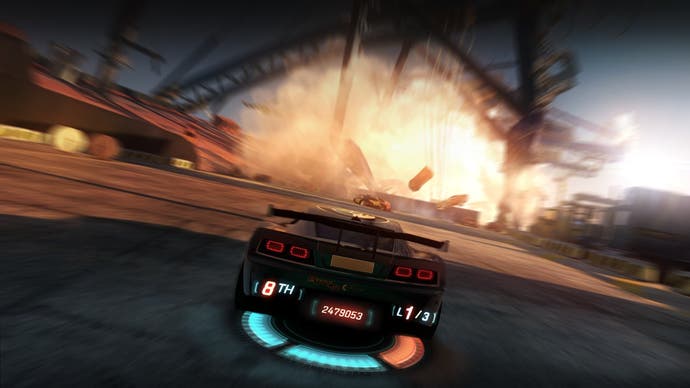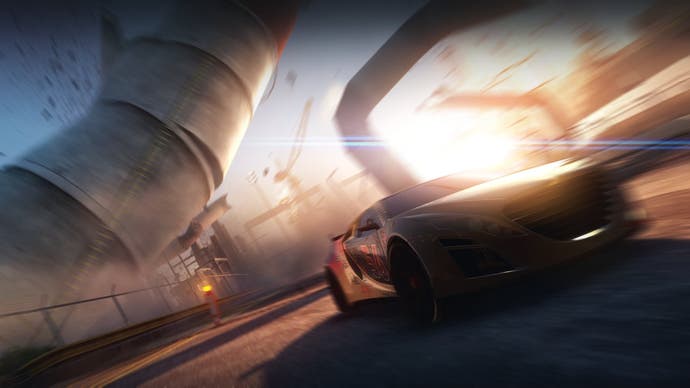Split/Second
Fire works.
The level of powerplay you can unleash is determined by a meter that is charged as you race. Coloured symbols corresponding to a controller button appear at relevant sections. As well as offering a moment of visual wonder (which can be savoured cinematically in slow-mo with a press of the shoulder button), shortcuts can be opened up as the environment crumbles in order to shave vital seconds off your lap times.
As undeniably spectacular as these signature moments are, the concern to an observer would be that powerplays are little more than scripted gimmicks. Absolutely not, insists Baynes. "Watching different people play it you do genuinely see people having different experiences in terms of what they're triggering and when. You can learn where things are on the track, but you can never predict exactly what's going to happen and when, so you've still got to rely on your reactions."
This is certainly borne out when we eventually get our hands on a pad to take a spin around the Dock circuit. At the first attempt I finish a lamentable seventh of eight. As early as my second attempt I've climbed to a respectable fourth, already beginning to deploy powerplays with a degree of strategy. Timing is everything, as a crane I set swinging utterly destroys my car.
EGTV's James Hills fares no better, turning the air barrel-blue as he first cranes himself in the face then, moments later, takes a bus-sized chunk of masonry on the chin. It's in these moments that Split/Second succeeds in being both terrifically engaging as a spectator sport and thrill ride.

Even with the strategic elements and the unpredictability, familiarity is bound to lessen the fun over time, so breadth and depth are essential. The driving model itself, as you would expect from a developer with a decade of driving games under its seatbelt, feels responsive, satisfying and subtle based on initial experiences.
What Black Rock refuses to discuss at this point are numbers. Baynes won't be drawn on the number of tracks, saying only that it will be "competitive". However, he claims pre-emptively that each course in the game is equal to one and a half courses in Project Gotham when split routes are taken into account.
And anyway, he's right in as much as breaking down a racing game to a laundry list of numbers of numbers tells you nothing of the experience and can be a distraction at this stage. Furthermore, it's likely the team simply doesn't know what's going to make the cut.

Two things raise themselves from the latest build of Split/Second: the most polished, complete courses look absolutely stunning and are joyfully carnage-strewn riots of fun to weave around, and meanwhile there's still a great deal of work to be done elsewhere or that's yet to be finalised.
Luckily, with the game not due until next summer, there should be at least another five months for this clearly talented team to fine-tune and finesse a title of considerable and unique potential - and it's the last 10-15 per cent of development that's likely to determine whether it fulfills that potential.
Bizarre Creations' Blur, another power-upped petrolhead coming in 2010, is also following the Hollywood action blueprint, but as a visual spectacle at least, Black Rock's effort feels grander. For a game that looks not just at its peers for inspiration, but to the likes of Half-Life 2 and Call of Duty, we hope the final twists are turns of development are negotiated successfully.
Split/Second is due out for PC, PS3 and Xbox 360 in summer 2010.


.jpg?width=291&height=164&fit=crop&quality=80&format=jpg&auto=webp)






